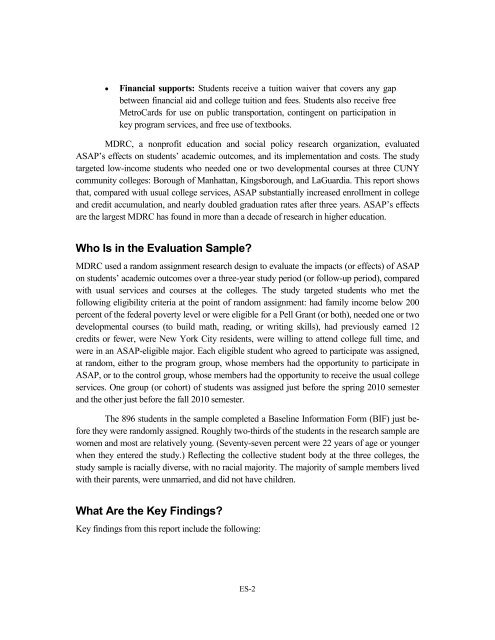1dOprzL
1dOprzL
1dOprzL
You also want an ePaper? Increase the reach of your titles
YUMPU automatically turns print PDFs into web optimized ePapers that Google loves.
• Financial supports: Students receive a tuition waiver that covers any gapbetween financial aid and college tuition and fees. Students also receive freeMetroCards for use on public transportation, contingent on participation inkey program services, and free use of textbooks.MDRC, a nonprofit education and social policy research organization, evaluatedASAP’s effects on students’ academic outcomes, and its implementation and costs. The studytargeted low-income students who needed one or two developmental courses at three CUNYcommunity colleges: Borough of Manhattan, Kingsborough, and LaGuardia. This report showsthat, compared with usual college services, ASAP substantially increased enrollment in collegeand credit accumulation, and nearly doubled graduation rates after three years. ASAP’s effectsare the largest MDRC has found in more than a decade of research in higher education.Who Is in the Evaluation Sample?MDRC used a random assignment research design to evaluate the impacts (or effects) of ASAPon students’ academic outcomes over a three-year study period (or follow-up period), comparedwith usual services and courses at the colleges. The study targeted students who met thefollowing eligibility criteria at the point of random assignment: had family income below 200percent of the federal poverty level or were eligible for a Pell Grant (or both), needed one or twodevelopmental courses (to build math, reading, or writing skills), had previously earned 12credits or fewer, were New York City residents, were willing to attend college full time, andwere in an ASAP-eligible major. Each eligible student who agreed to participate was assigned,at random, either to the program group, whose members had the opportunity to participate inASAP, or to the control group, whose members had the opportunity to receive the usual collegeservices. One group (or cohort) of students was assigned just before the spring 2010 semesterand the other just before the fall 2010 semester.The 896 students in the sample completed a Baseline Information Form (BIF) just beforethey were randomly assigned. Roughly two-thirds of the students in the research sample arewomen and most are relatively young. (Seventy-seven percent were 22 years of age or youngerwhen they entered the study.) Reflecting the collective student body at the three colleges, thestudy sample is racially diverse, with no racial majority. The majority of sample members livedwith their parents, were unmarried, and did not have children.What Are the Key Findings?Key findings from this report include the following:ES-2


